How to Remove McAfee Webadvisor?
In today’s digitally-driven world, where online threats are present at every corner, McAfee WebAdvisor stands as a vigilant guardian, offering an added layer of security. This tool serves a crucial role in steering users away from phishing sites and malicious downloads, ensuring that your online browsing is safe and sound. It functions seamlessly across various browsers, notably through the McAfee WebAdvisor Chrome extension, safeguarding your digital life without you even noticing it’s there.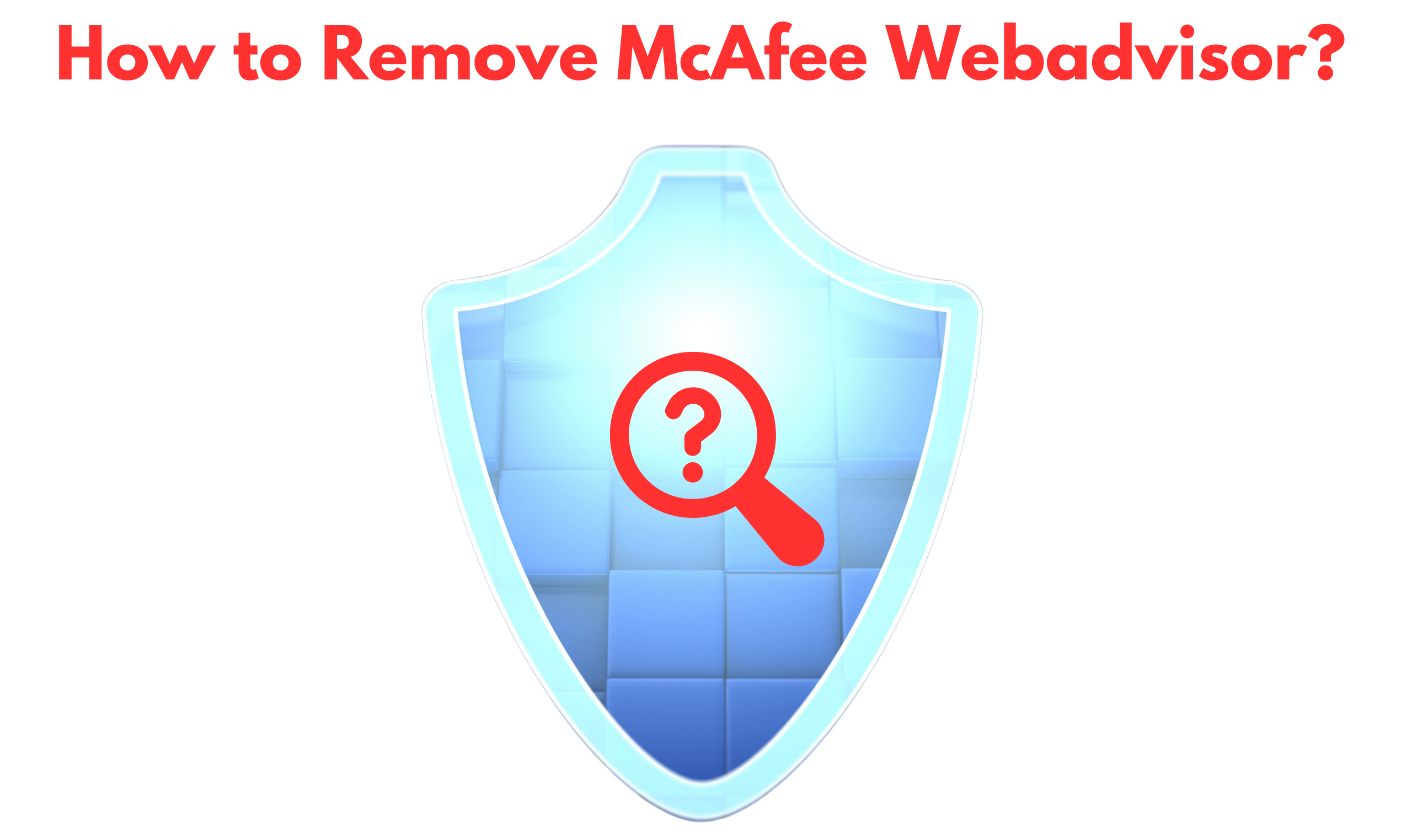
However, there are times when you might find the need to delete McAfee WebAdvisor. Whether you’re seeking to lighten your system’s load, experiencing performance hiccups, or simply opting to switch to a different security tool that fits your needs better, understanding how to effectively remove McAfee WebAdvisor is essential. Some users may choose to disable McAfee WebAdvisor if they find it overly protective or if it conflicts with other software on their system.
No matter the reason, whether it’s to uninstall McAfee WebAdvisor due to redundancy, system resource management, or an upgrade to a more robust solution, the process should be straightforward and thorough. It’s crucial to maintain the optimal performance of your devices and ensuring that your new security solutions function without interference. In the following sections, we will guide you through the necessary steps to remove McAfee WebAdvisor effectively, ensuring that every trace of this extension is cleanly wiped from your system.
Preparing to Uninstall McAfee WebAdvisor
Before you proceed to uninstall McAfee WebAdvisor, understanding the importance of a proper uninstallation process is crucial. This isn’t just about removing an application; it’s about ensuring your computer continues to run smoothly afterward. Improper uninstallation can leave behind traces of the McAfee WebAdvisor extension, which may clog your system, leading to reduced performance and potential conflicts with other applications. Therefore, to delete McAfee WebAdvisor effectively, one must follow a careful approach to prevent these issues.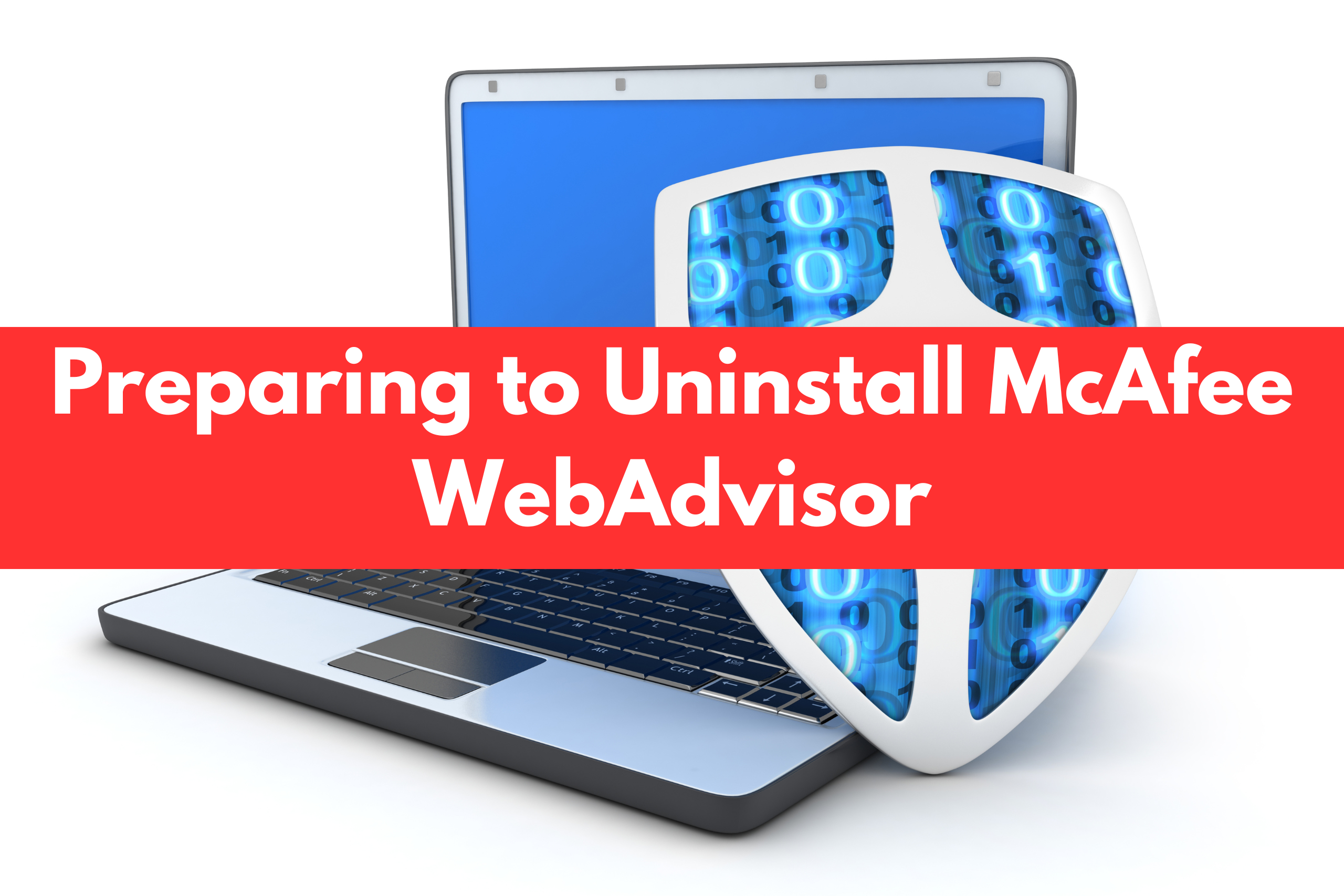
Importance of Proper Uninstallation
The primary goal when you remove McAfee WebAdvisor is to ensure that no associated files or registry entries stay on your system. Leftover components can slow down your computer, cause errors with future software installations, or even affect the stability of your operating system. It’s essential to thoroughly uninstall McAfee WebAdvisor to maintain the health and efficiency of your PC or Mac.
Things to Check before Uninstalling McAfee Webadvisor
-
Backup Important Data:
Before you start the McAfee WebAdvisor uninstallation process, make sure to backup any important data related to the software. This includes bookmarks or security settings that you might want to restore later or transfer to another security solution.
-
Check for Dependent Software:
Sometimes, other applications might rely on the security features provided by McAfee WebAdvisor. Check if removing the McAfee WebAdvisor will impact any security functionalities in other software you use. This is particularly important in a business environment where multiple security layers might interact.
-
Prepare Your New Security Solution:
If you are planning to disable McAfee WebAdvisor because you’re switching to a new security tool, ensure the new software is ready for installation before you remove the old one. This minimizes the time your system operates without active protection against threats.
By carefully preparing for the McAfee WebAdvisor uninstallation, you can ensure a smooth transition and maintain optimal performance of your system. The next steps will guide you through the actual uninstallation process, whether you’re on Windows or Mac, to completely remove McAfee WebAdvisor without leaving a trace.
How to Uninstall McAfee WebAdvisor on Windows
Removing McAfee WebAdvisor from your Windows system is a straightforward process, but it requires attention to detail to ensure that the uninstallation is complete and effective. Here, we will guide you through each step to remove McAfee WebAdvisor and troubleshoot any common issues that might arise.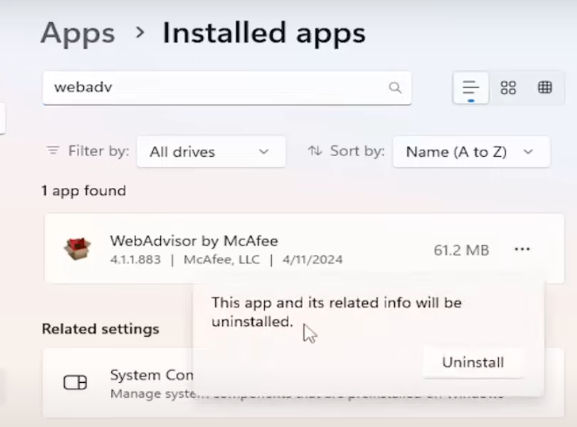
Step-by-Step Instructions
-
Accessing the Control Panel:
- Click on the Start menu or press the Windows key.
- Type “Control Panel” into the search box and select the Control Panel app from the results.
-
Navigating to Programs and Features:
- In the Control Panel, find and click on “Programs” or “Programs and Features” depending on your view settings.
- This section lists all the programs installed on your computer.
-
Locating McAfee WebAdvisor in the list:
- Go through the list of installed programs until you find McAfee WebAdvisor.
- Click on it to select it.
-
Executing the uninstallation:
- With McAfee WebAdvisor selected, click on “Uninstall” or “Change/Uninstall” at the top of the list.
- Follow the on-screen instructions carefully to complete the uninstallation process. This may involve confirming that you want to remove McAfee WebAdvisor and waiting for the uninstaller to run through its process.
Troubleshooting Common Issues
During the McAfee WebAdvisor uninstallation process, you might encounter some common issues. Here are troubleshooting tips to help you address them:
-
Uninstallation Errors:
If you receive an error during uninstallation, restart your computer and attempt the uninstallation again. This can resolve issues caused by system resources being in use.
-
Stubborn Residual Files:
After uninstalling, if you suspect that some components of the McAfee WebAdvisor extension are still present, consider using a third-party uninstaller tool to search for and remove leftover files.
-
Reinstallation Problems:
If you’re trying to uninstall McAfee WebAdvisor to reinstall it or replace it with another version but face issues, ensure that all files from the previous installation are completely removed. Check your program files and app data folders for any lingering McAfee folders and delete them.
-
Browser Issues:
Sometimes, even after you remove McAfee WebAdvisor, your browser might still show signs of the extension. In this case, manually disable McAfee WebAdvisor from your browser’s extension settings and restart the browser.
By following these steps and troubleshooting tips, you can make sure that you uninstall McAfee WebAdvisor effectively from your Windows system, leaving your machine clean and ready for new software.
Also Read: How to Stop McAfee Pop-ups
How to Uninstall McAfee WebAdvisor on Mac
Uninstalling McAfee WebAdvisor on a Mac is a different process from Windows due to the operating system’s unique structure and navigation style. Here’s a detailed section on how to effectively remove McAfee WebAdvisor from your macOS, ensuring that the application is completely deleted without leaving any residual files behind.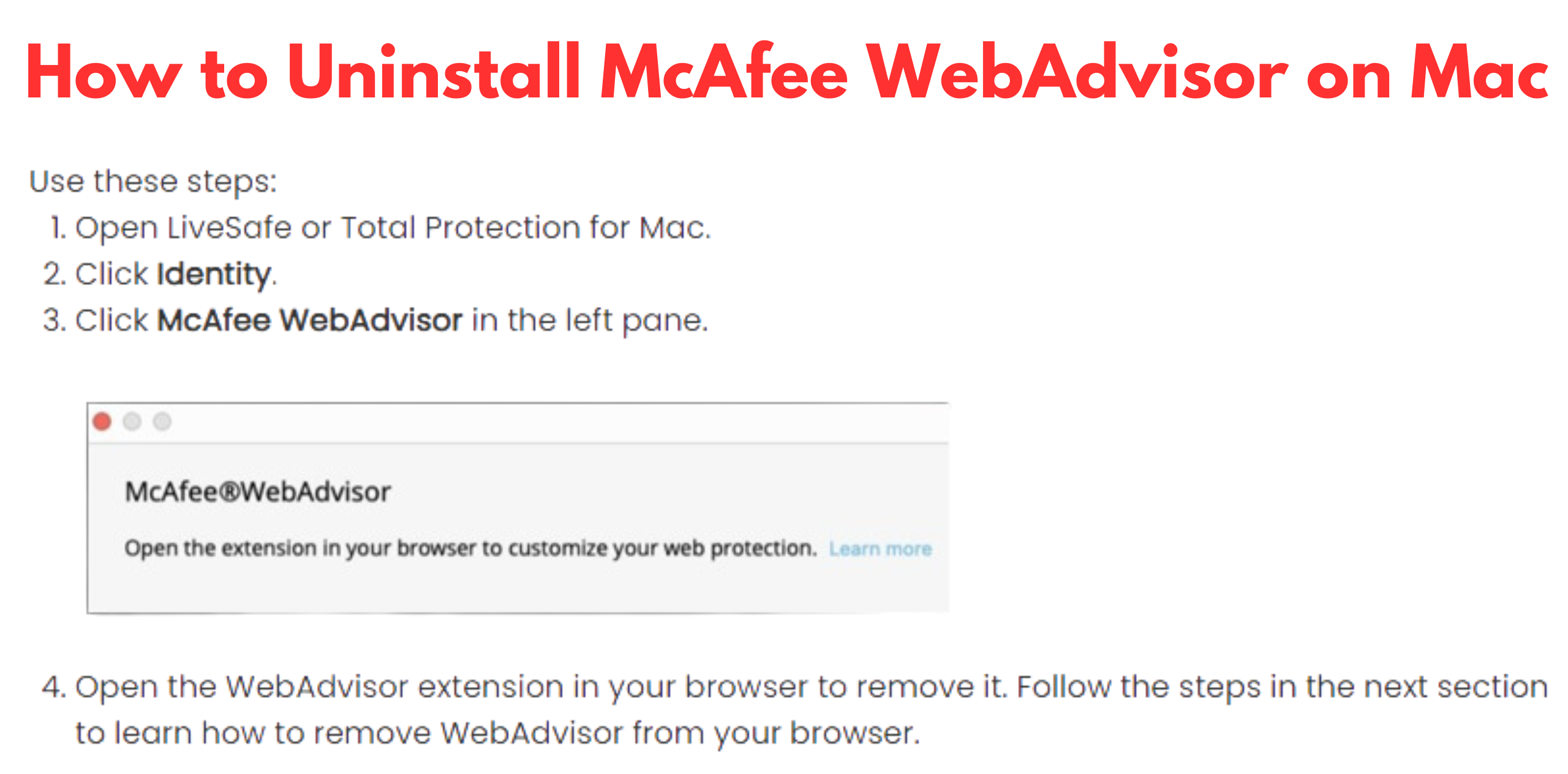
Step-by-Step Instructions
-
Opening the Finder:
- Click on the Finder icon in your dock to open a new Finder window.
- Ensure you are on the Finder application as this is where you’ll perform most of the uninstallation steps.
-
Navigating to the Applications Folder:
- In the Finder sidebar, click on “Applications,” which is where all installed applications are listed.
-
Finding McAfee WebAdvisor:
- Scroll through your Applications list or use the search function at the top right of the Finder window to find McAfee WebAdvisor.
-
Dragging the Application to the Trash:
- Click and drag the McAfee WebAdvisor icon to the Trash icon in your Dock. This moves the application out of your Applications folder and into the Trash.
-
Emptying the Trash to Complete the Uninstallation:
- Right-click on the Trash icon in your Dock and select “Empty Trash.”
- Confirm that you want to permanently remove the items in your Trash, which includes McAfee WebAdvisor.
Troubleshooting Tips
While the uninstallation process is typically straightforward, Mac users might face some issues when trying to delete McAfee WebAdvisor. Here are some common problems and solutions:
-
Application is Running:
If McAfee WebAdvisor is running, you might not be able to move it to Trash. Make sure to quit the application completely by right-clicking on the icon in the Dock, then choosing “Quit.” If it doesn’t quit normally, force quit the application by pressing Cmd + Opt + Esc, selecting McAfee WebAdvisor, and clicking “Force Quit.”
-
Residual Files Remaining:
Mac applications can leave behind configuration files even after being dragged to the Trash. To fully remove McAfee WebAdvisor, you may want to look for leftover files in the following locations:
- ~/Library/Application Support/
- ~/Library/Preferences/
- Search for any files or folders containing “McAfee” or “WebAdvisor” and delete them.
-
Permission Issues:
If you receive a message saying you do not have permission to delete McAfee WebAdvisor, you will need to adjust the permissions. Right-click on the application in the Applications folder, select “Get Info,” unlock the padlock at the bottom, and set the privilege to “Read & Write” for your user. Then try moving it to Trash again.
By following these steps and troubleshooting any issues, you can successfully uninstall McAfee WebAdvisor on your Mac, ensuring your system remains clean and efficient without unnecessary software.
Additional Methods to Remove McAfee Webadvisor
Sometimes, the standard methods to remove McAfee WebAdvisor may not be enough, especially if the software leaves behind residual files or registry entries. In such cases, considering alternative approaches can be necessary to ensure a clean and complete removal. Below, we explore the use of dedicated uninstall tools and provide manual removal tips for those tricky scenarios where McAfee WebAdvisor refuses to leave quietly.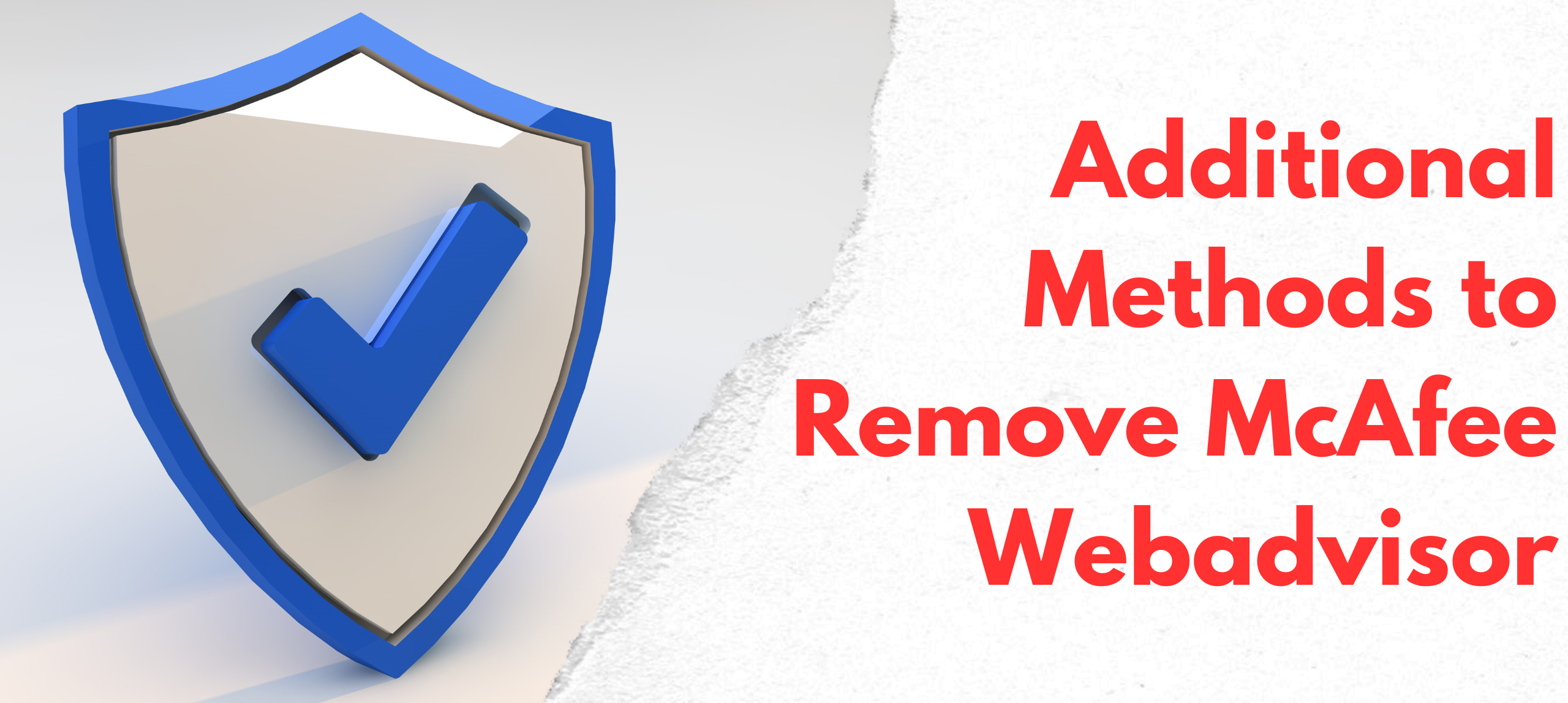
Using Dedicated Uninstall Tools
For those stubborn applications that don’t go away easily, third-party uninstall tools can be a lifesaver. These tools are designed to remove McAfee WebAdvisor and other similar software more thoroughly than the standard uninstall process allows.
-
Revo Uninstaller (Windows):
This tool digs deeper than the typical uninstall process, removing residual files and registry entries that might be left behind. It’s particularly effective for cleaning up after messy uninstalls.
-
AppCleaner (Mac):
AppCleaner allows Mac users to delete McAfee WebAdvisor completely by finding and removing all associated files that aren’t deleted when simply dragging an app to the Trash.
When using these tools, select the option for a deep or thorough scan to ensure that all files related to the McAfee WebAdvisor extension are identified and removed. This can help prevent slowdowns and conflicts with other programs down the line.
Manual Removal Tips
If you prefer a more hands-on approach or if other methods fail, manual removal can be the next step. Here’s how to ensure you delete McAfee WebAdvisor thoroughly from your system manually:
-
Access Hidden Files:
- For Windows, open the File Explorer, go to the “View” tab, and check “Hidden items” to reveal any hidden files associated with McAfee WebAdvisor.
- On Mac, open Finder, press Command + Shift + Dot to show hidden files.
-
Search and Remove in System Folders:
- Look in system directories such as Program Files, ProgramData (Windows), or Library/Application Support (Mac). Be cautious and ensure you are only deleting files related to McAfee WebAdvisor.
-
Clean the Registry (Windows Only):
- Open the Registry Editor by typing regedit in the Windows search bar and navigate to HKEY_LOCAL_MACHINE and HKEY_CURRENT_USER. Carefully search for any registry keys or values associated with McAfee WebAdvisor and delete them. Note: Modifying the registry can be risky, so this step is recommended for advanced users or those with technical support.
-
Restart Your System:
- After manually deleting files and registry entries, restart your computer to clear any loaded files and finalize the removal process.
By using dedicated uninstall tools or opting for manual removal, you can effectively remove McAfee WebAdvisor from your system when the standard uninstallation fails. These methods ensure that your device remains clean, fast, and free of unwanted software remnants.
Ensuring Complete Removal of McAfee Webadvisor
After you’ve taken steps to remove McAfee WebAdvisor, it’s essential to verify that the uninstallation process was comprehensive and that no residual files or registry entries have been left behind. These traces can clutter your system, potentially causing slowdowns or conflicts with other software. Here’s how you can ensure that you have successfully removed McAfee WebAdvisor from your system.
How to Check Your System
-
Search for Residual Files:
- On Windows, open the File Explorer and use the search bar to look for any remaining files that contain “McAfee” or “WebAdvisor.” Make sure to check common locations such as C:\Program Files\, C:\Program Files (x86)\, and C:\Users\[YourUsername]\AppData\.
- On Mac, use the Finder to search in the /Applications/, ~/Library/Application Support/, and ~/Library/Preferences/ directories. You can initiate a system-wide search using Spotlight (Cmd + Space) and typing “McAfee” or “WebAdvisor” to find any leftover files.
-
Review Installed Programs and Features:
- On Windows, revisit the Control Panel under Programs and Features to ensure McAfee WebAdvisor is no longer listed. On Mac, check the Applications folder again to confirm the app is not present.
-
Check Browser Extensions:
- Open each browser where the McAfee WebAdvisor Chrome extension or other browser extensions were installed. Navigate to the extensions menu to confirm that all components associated with McAfee WebAdvisor are gone.
Cleaning System Registry (for Windows)
Editing the Windows Registry can be risky if not done correctly, as improper modifications can lead to system instability or operational issues. If you are comfortable proceeding, here is a step-by-step guide to cleaning your system registry from entries related to McAfee WebAdvisor:
-
Backup the Registry:
Before making any changes, it’s crucial to back up the registry. Open the Registry Editor by typing “regedit” in the Windows search bar, then click on File > Export to save a complete backup.
-
Locate McAfee WebAdvisor Entries:
With the Registry Editor open, use the Edit > Find feature and type “McAfee WebAdvisor” to locate any associated entries. You may need to press F3 to find next until all entries have been found.
-
Delete Relevant Keys:
Carefully review each discovered entry to ensure it relates specifically to McAfee WebAdvisor. Delete any relevant keys or values by right-clicking them and selecting ‘Delete’. Be very cautious to only remove items that are clearly identified as part of McAfee WebAdvisor.
-
Restart Your Computer:
Once the cleanup is complete, restart your computer to apply changes and refresh the system.
By following these thorough checks and cleanups, you can be confident that McAfee WebAdvisor has been completely deleted from your system, helping maintain its performance and stability. If you’re unsure about any steps, especially with registry editing, consider seeking assistance from a professional to ensure safety and accuracy.
FAQs
Q1. Why might someone want to uninstall McAfee WebAdvisor?
- A. Users might want to uninstall McAfee WebAdvisor if they are switching to a different security tool, experiencing performance issues, or find it conflicts with other software.
Q2. How can I safely uninstall McAfee WebAdvisor from my Windows computer?
- A. To safely remove McAfee WebAdvisor on Windows, access the Control Panel, navigate to Programs and Features, locate McAfee WebAdvisor, and follow the uninstallation prompts.
Q3. What are the steps to delete McAfee WebAdvisor from a Mac?
- A. To delete McAfee WebAdvisor on Mac, open Finder, go to the Applications folder, drag the McAfee WebAdvisor app to the Trash, and then empty the Trash.
Q4. Are there any tools recommended for completely removing McAfee WebAdvisor?
- A. Yes, tools like Revo Uninstaller for Windows and AppCleaner for Mac are recommended to thoroughly remove McAfee WebAdvisor and all associated files.
Q5. What should I do if I can’t uninstall McAfee WebAdvisor through the standard method?
- A. If the standard method fails, you can use dedicated uninstall tools or manually search for and delete McAfee WebAdvisor files in system folders like Program Files or Library/Application Support.
Q6. How can I ensure all components of McAfee WebAdvisor are removed from my browser?
- A. Check your browser’s extensions or add-ons settings and ensure the McAfee WebAdvisor Chrome extension or other related extensions are completely disabled and removed.
Q7. What precautions should I take before editing the registry to remove McAfee WebAdvisor?
- A. Always back up the registry before making changes to ensure you can restore your system if something goes wrong while removing entries related to McAfee WebAdvisor.
Q8. Can disabling McAfee WebAdvisor affect my computer’s security?
- A. Disabling or removing McAfee WebAdvisor may reduce your system’s defense against online threats unless replaced by another effective security solution.
Conclusion
Thoroughly uninstalling security software is crucial for the health and performance of your computer. In this blog, we’ve emphasized the importance of completely removing McAfee WebAdvisor and detailed the steps required to ensure no traces remain that could clutter or compromise your system.
Leaving fragments of uninstalled programs, especially security software, can lead to decreased system performance, startup delays, software conflicts, or even security vulnerabilities. That’s why it’s essential not only to disable McAfee WebAdvisor but to make sure it is entirely removed from your system.
We outlined the process to remove McAfee WebAdvisor for both Windows and Mac systems, ensuring you can follow through depending on your operating system. This includes using standard uninstall procedures as well as employing third-party tools for a more thorough cleanup. For cases where automated tools don’t catch everything, we also discussed how to manually search for and eliminate any remaining McAfee WebAdvisor files, focusing particularly on hidden files and registry entries.
Regular system maintenance, even after the McAfee WebAdvisor uninstallation, is crucial for maintaining optimal performance and security. This practice prevents the accumulation of unused files and data which can slow down your system. By ensuring that McAfee WebAdvisor and similar programs are completely removed, you safeguard your system’s efficiency and protect against potential security threats. We encourage users to regularly review their installed applications, especially security tools, to ensure they remain relevant and effective without compromising system performance. Remember, keeping your system clean and well-maintained is not just about enhancing performance—it’s about ensuring a secure and efficient digital environment. Whether you decide to delete McAfee WebAdvisor or any other application, thorough uninstallation is key to maintaining a healthy digital life.
For more information, you can go to our McAfee Support page.
